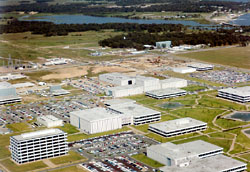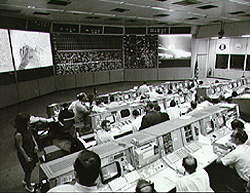
The Apollo Mission Control Center, in Building 30 at the Lyndon B. Johnson Manned Space Flight Center in Houston, Texas, consists of a mission operations wing (MOW), operations support wing (OSW) and an interconnecting lobby wing. This facility was used to monitor nine Gemini and all Apollo flights, including the flight of Apollo 11 that first landed men on the moon. The Apollo Mission Control Center, provided critical support to the success of the mission, exercised full mission control of the flight of Apollo 11 from the time of liftoff from Launch Complex 39 at the Kennedy Space Center to the time of splashdown in the Pacific.

The technical management of all areas of vehicle systems of Apollo 11 including flight dynamics, life systems, flight crew activities, recovery support and ground operations were handled at the Apollo Mission Control Center. Through the use of television and the print news media the scene of activity at the Apollo Mission Control during the first manned landing on the moon was made familiar to millions of Americans. When Neil Armstrong reported his "That's one small step for a man, one giant leap for mankind" to Mission Control his words went immediately around the world and into history. After the end of the Apollo Program this facility was used to monitor manned spaceflights for Skylab, Apollo-Soyuz and all recent Space Shuttle flights. For most Americans the Apollo Mission Control Center and Launch Complex 39 at the Kennedy Space Center symbolize achievements of the manned space program.
Visit the National Park Service Travel American Aviation to learn more about Aviation related Historic Sites.
Last updated: August 28, 2017
